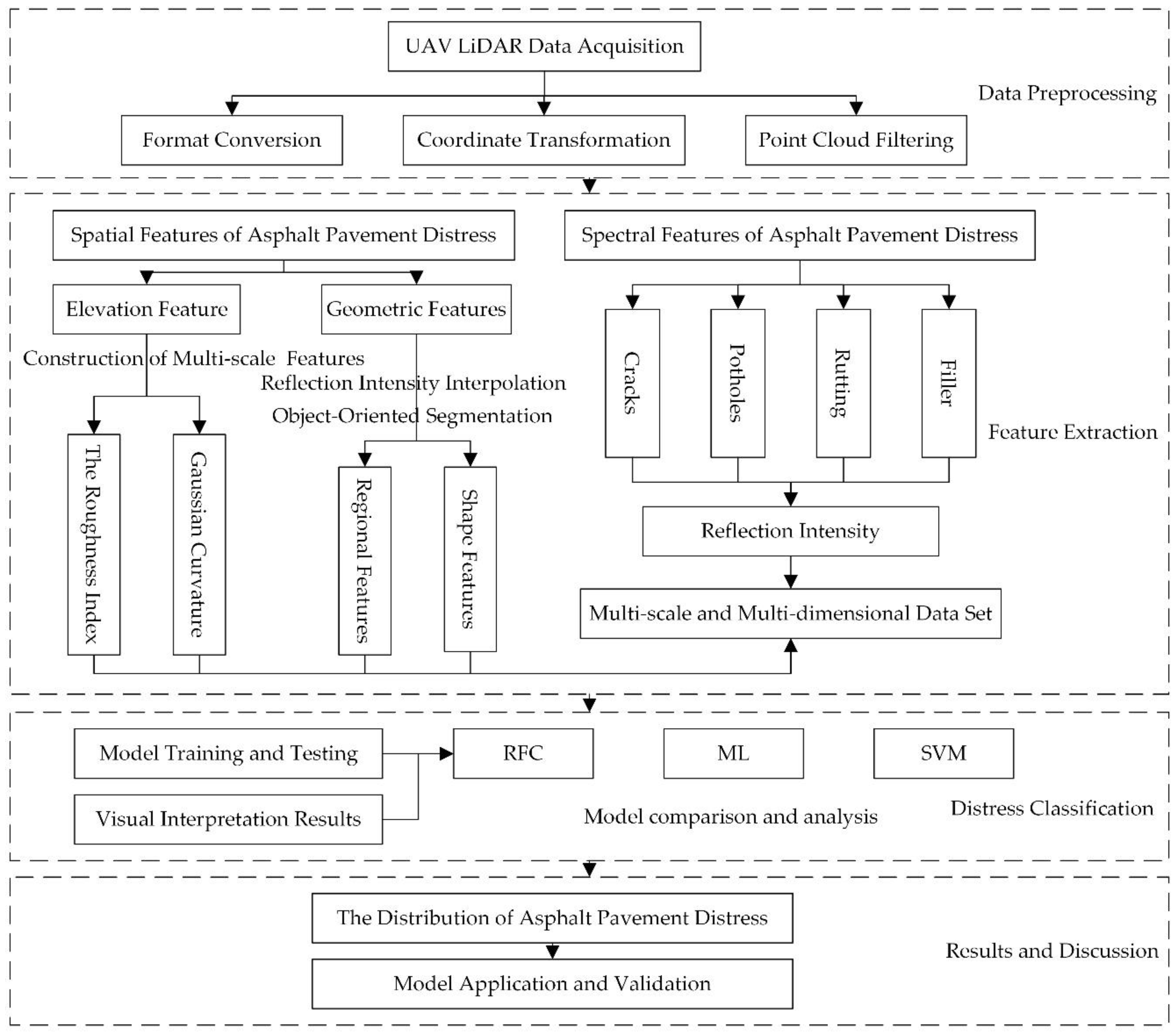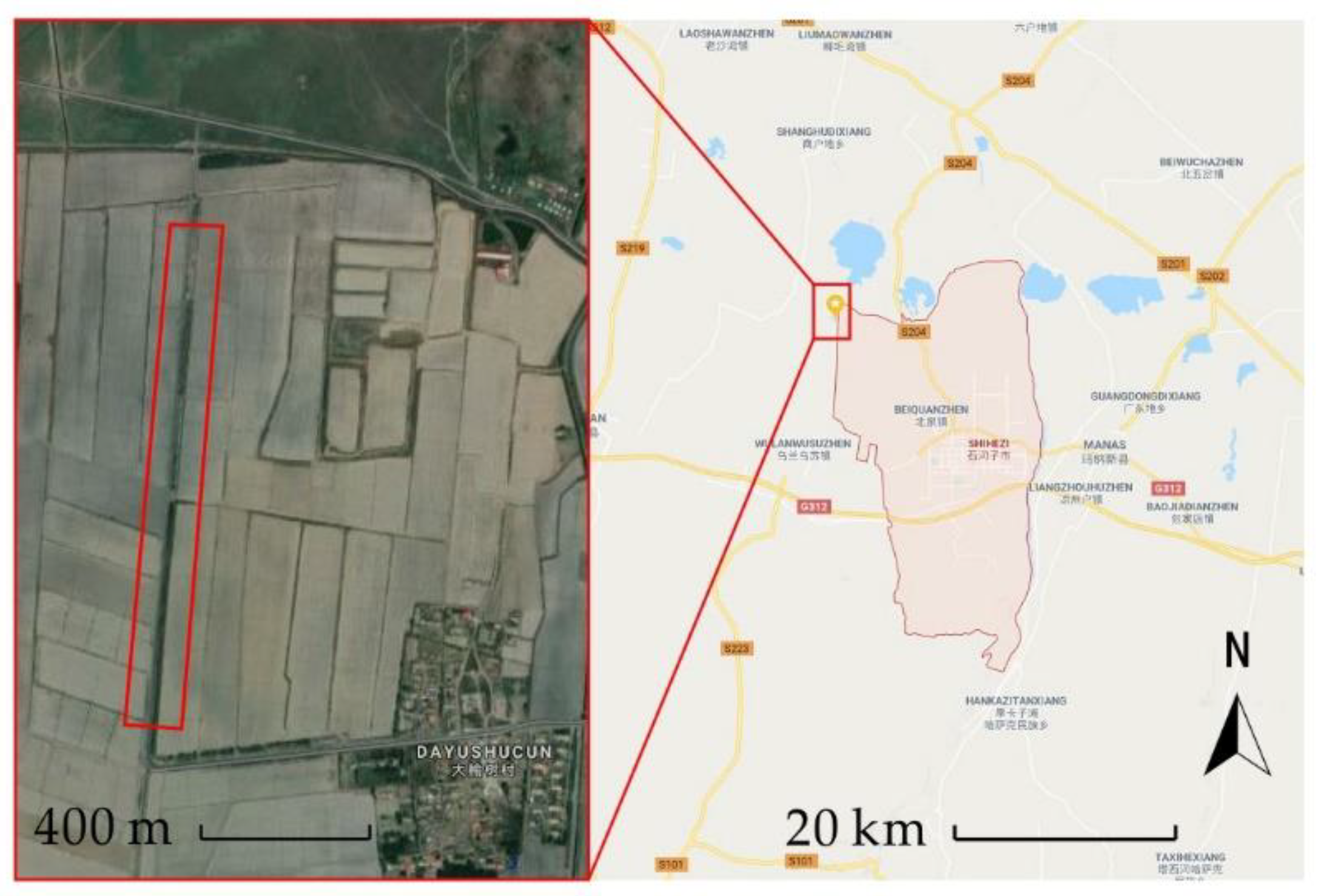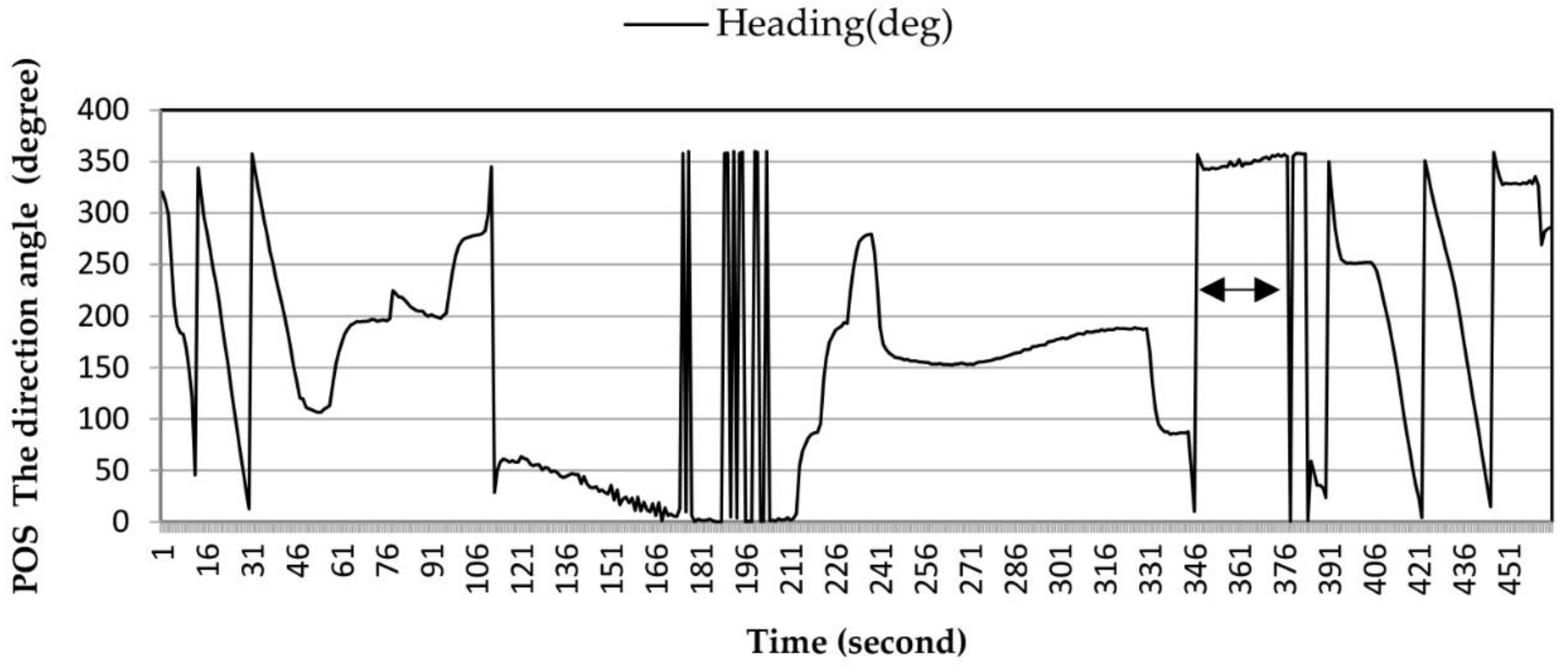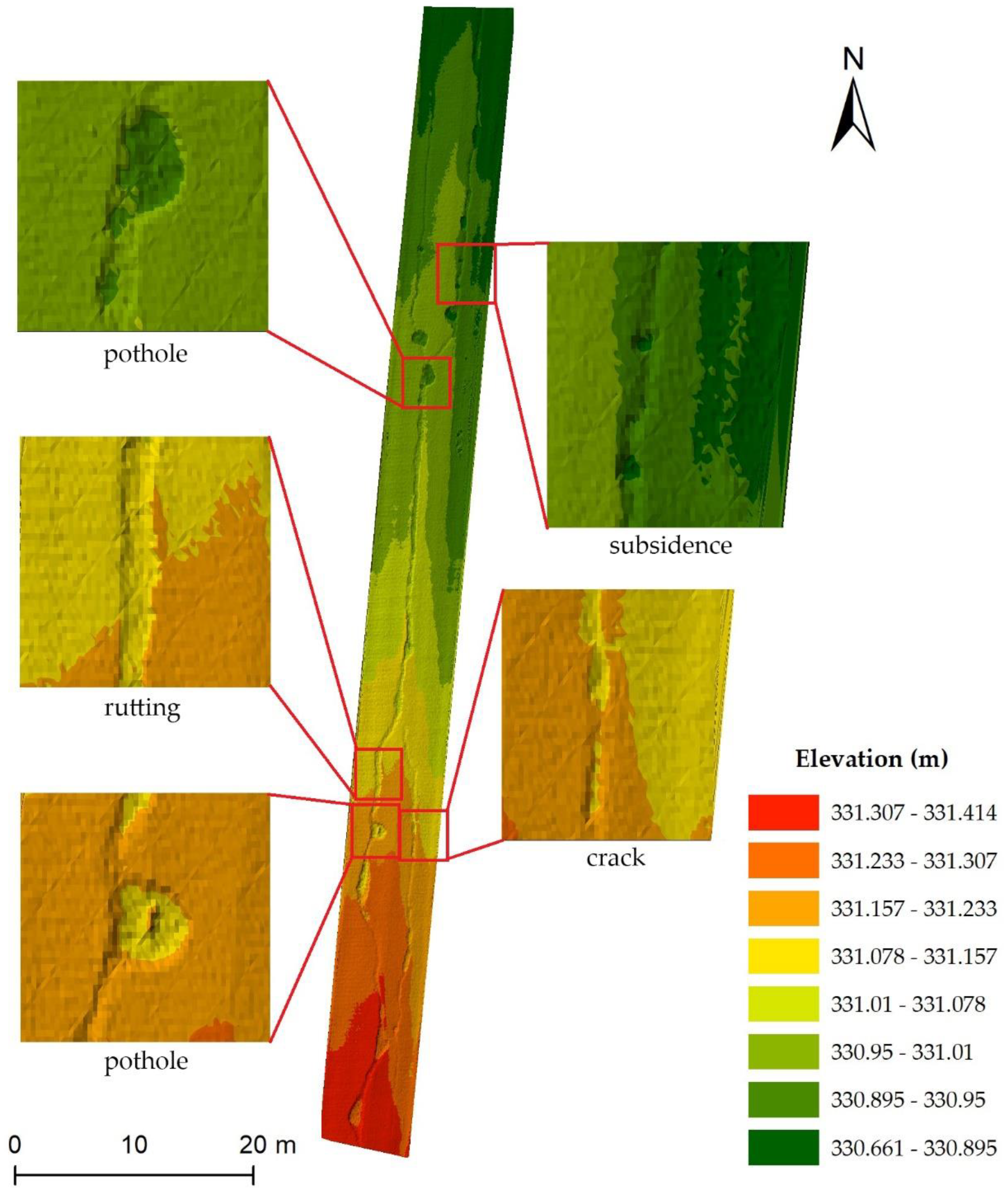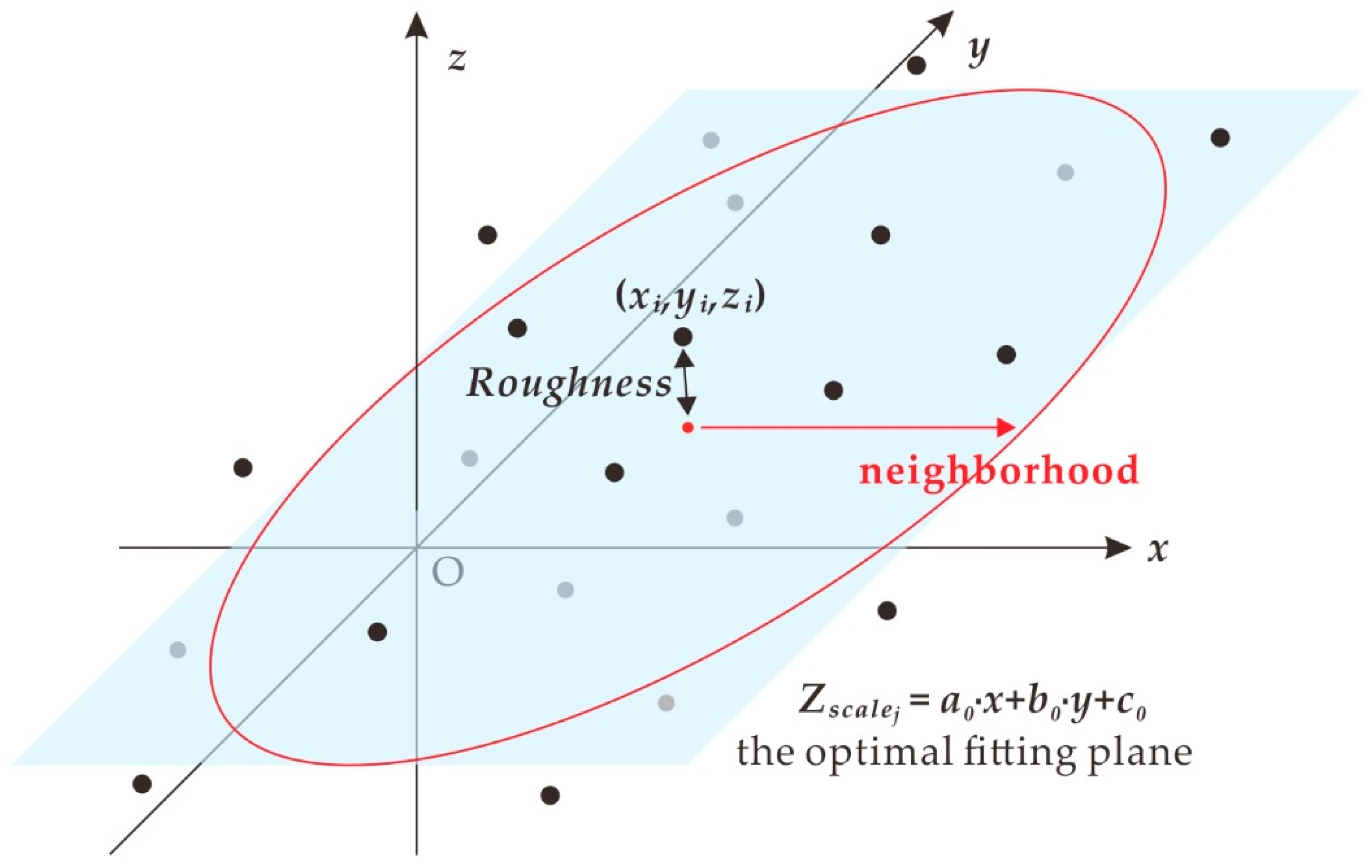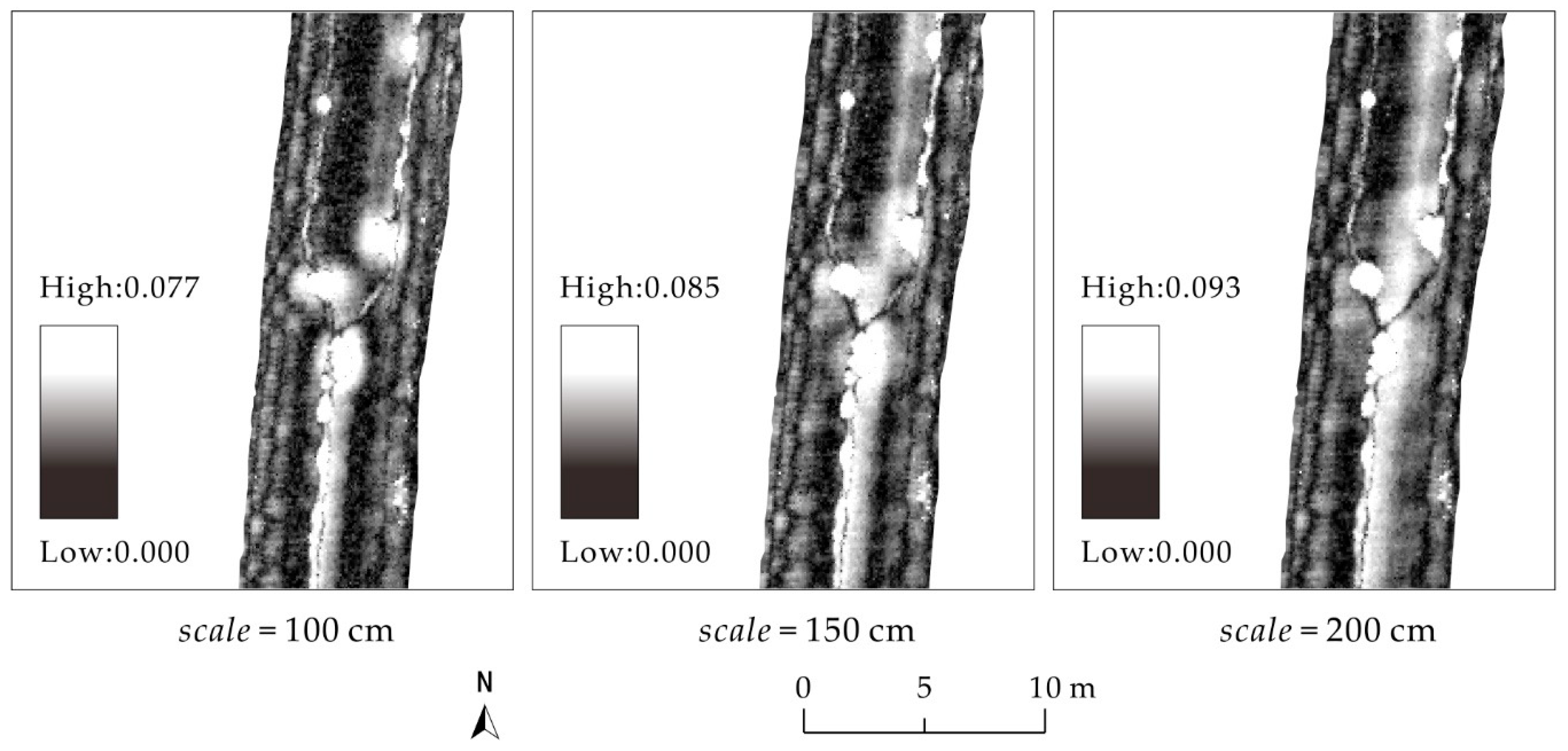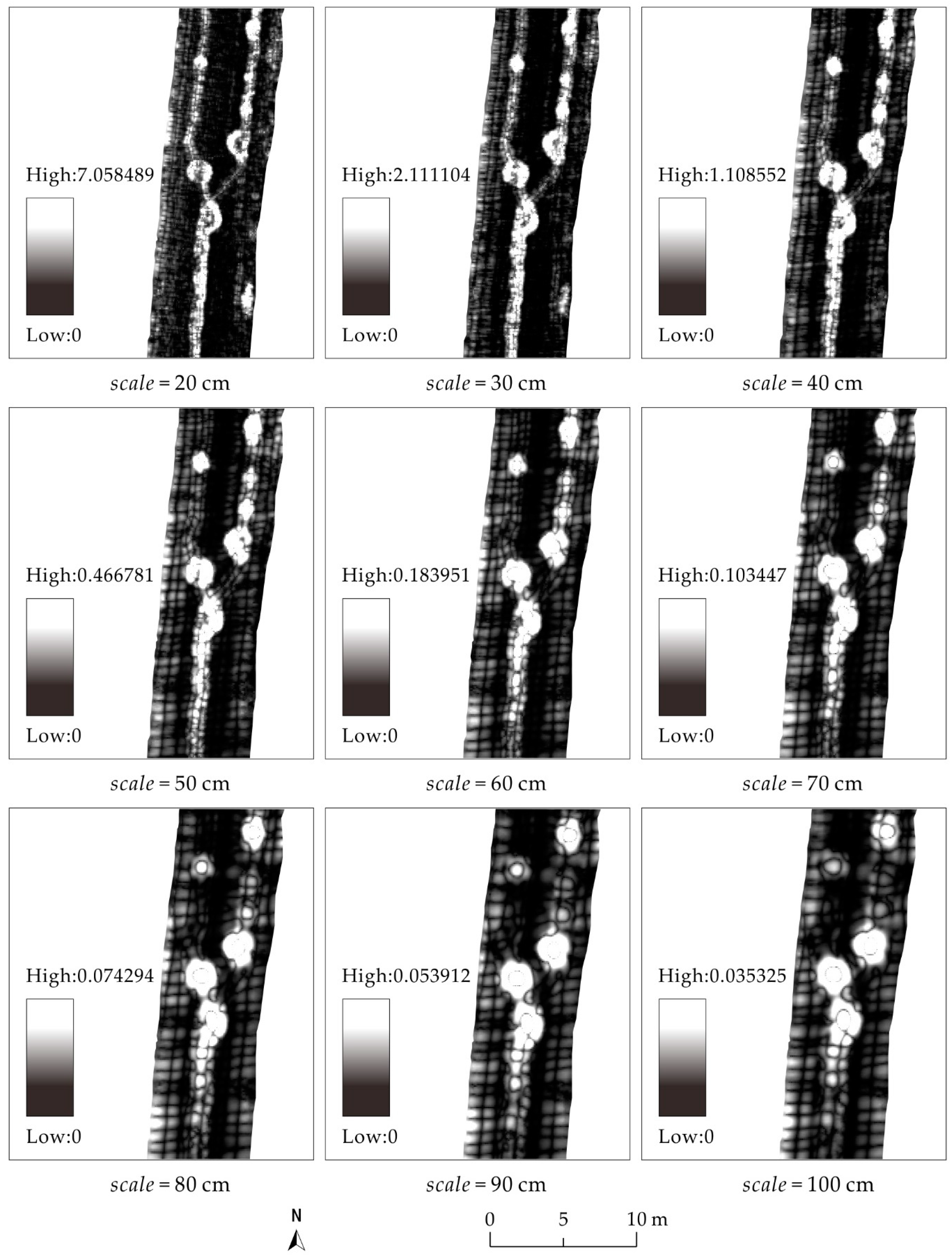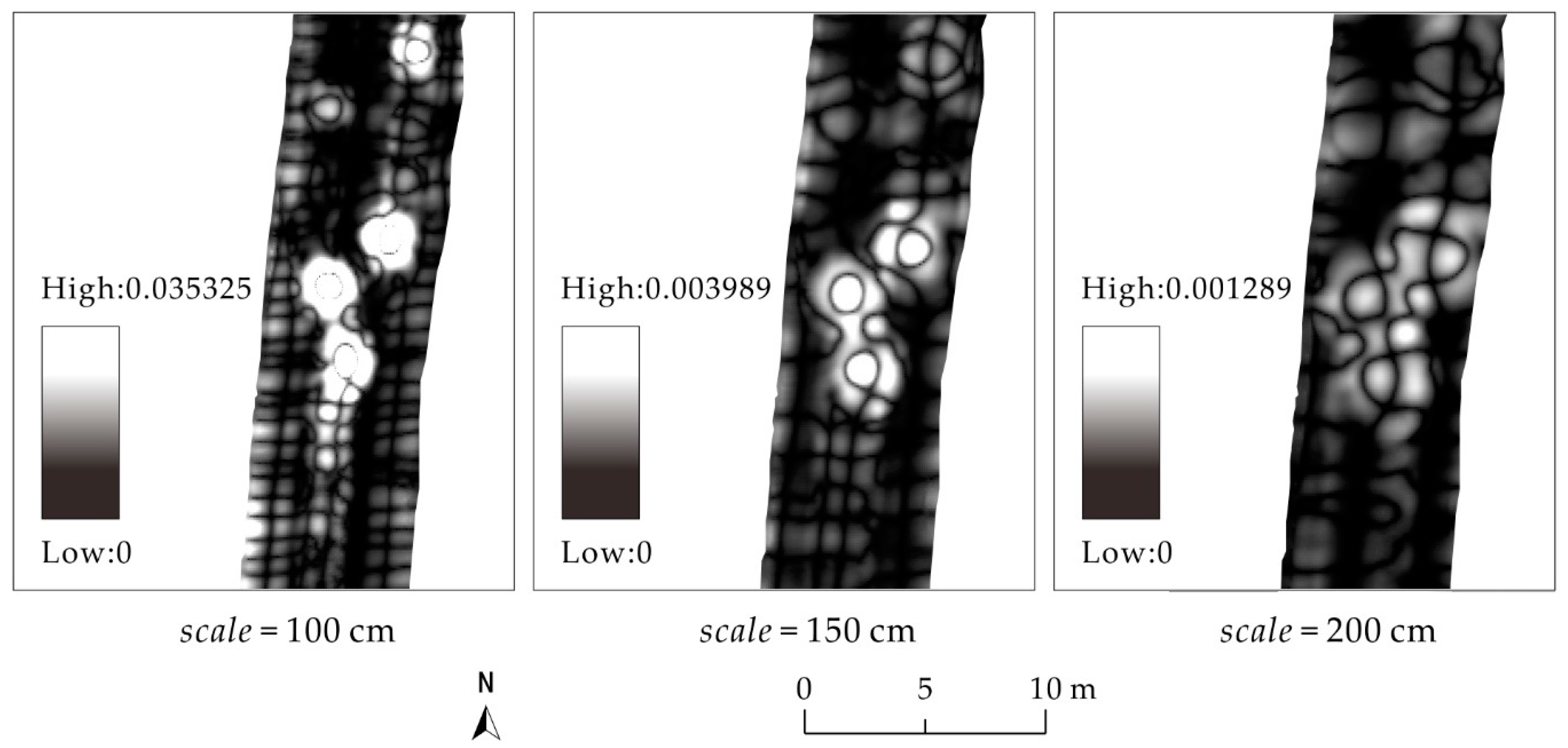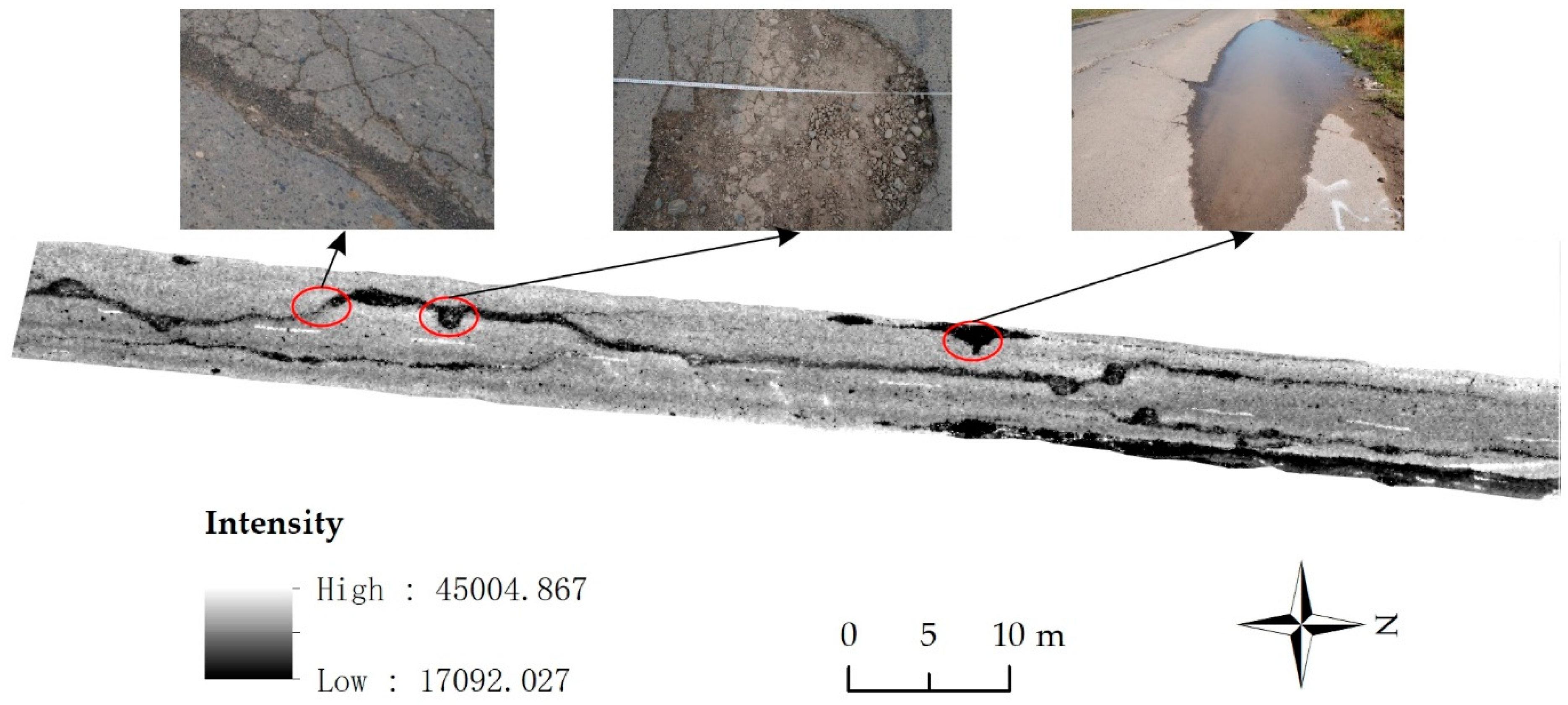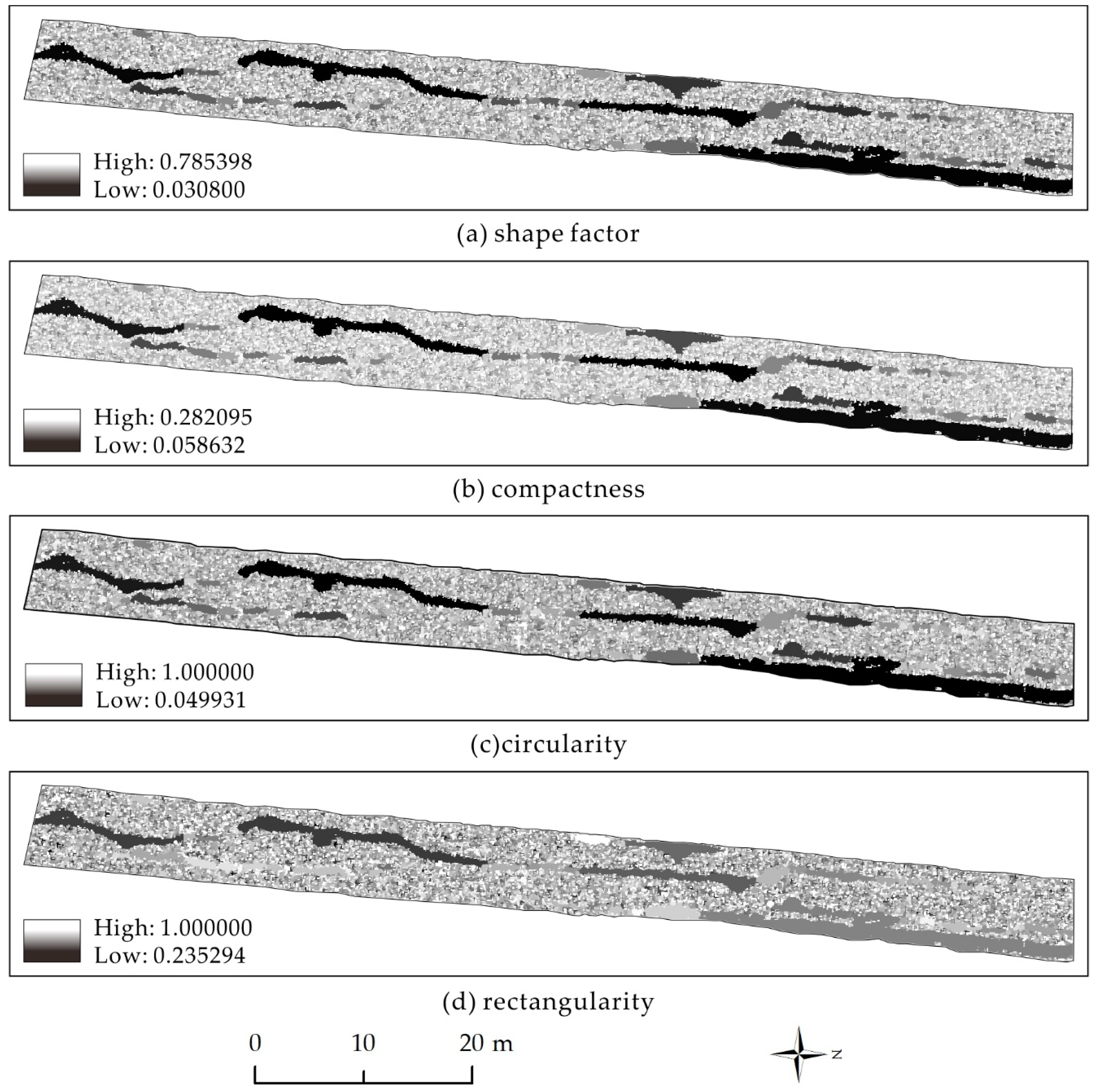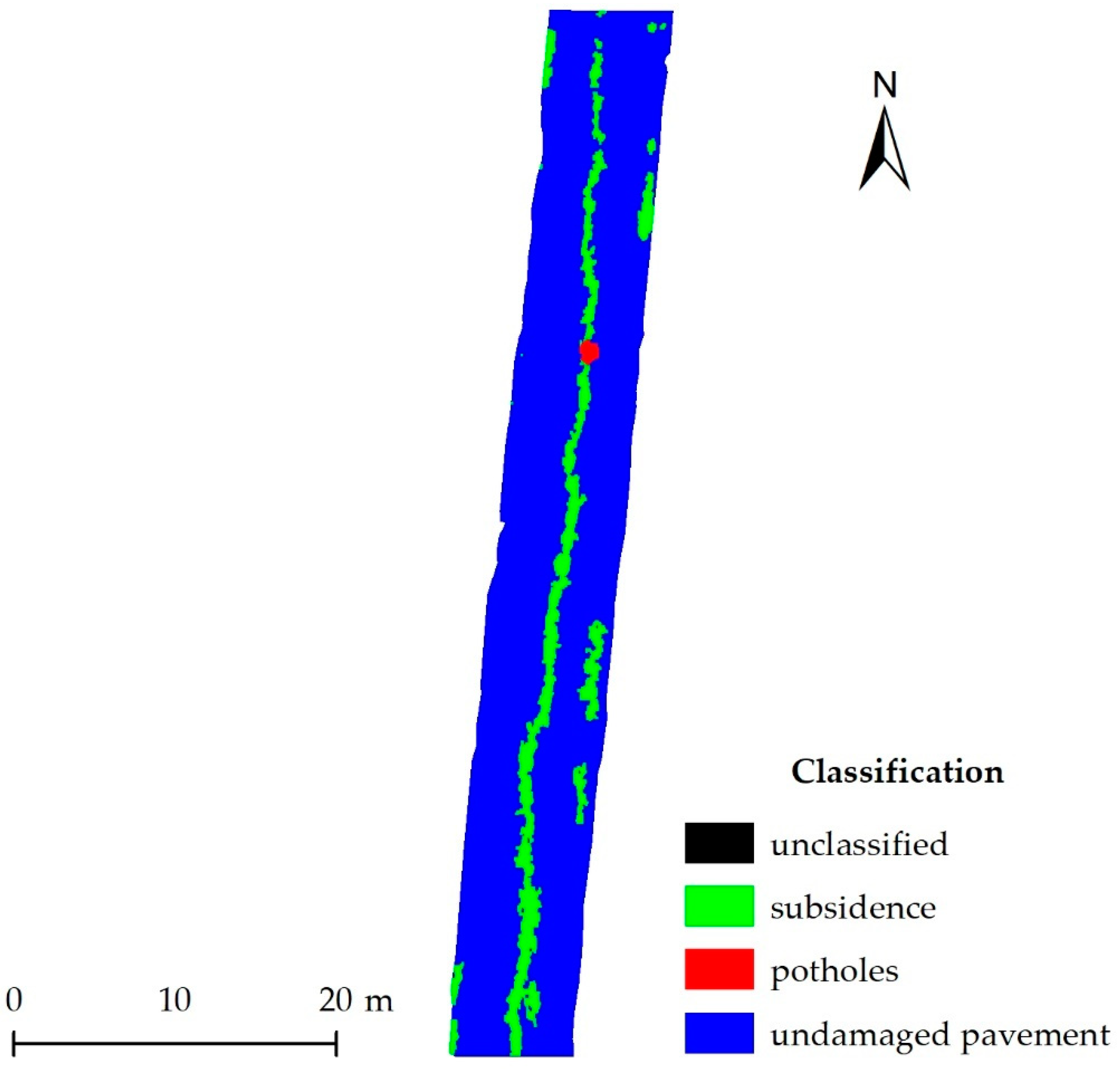1. Introduction
Highways are a strategic resource in a country and they provide the basis of social development [
1]. With the development of China’s economy, highway construction has made great progress. By the end of 2017, China’s total highway mileage was 4,773,500 km [
2]. Many factors (such as temperature, moisture, weathering, and loads) [
3,
4,
5] can adversely affect pavement structure and result in a variety of road distresses, which not only influence the normal use of highways, but also lead to large economic losses. Therefore, identifying pavement distress is of great significance for road condition monitoring, road maintenance, and road management [
6,
7].
Many evaluation indexes (such as the pavement condition index, pavement roughness index, riding quality index, and pavement structure strength index) have been used to measure pavement quality and usage status [
8,
9]. To obtain these indexes, it is imperative to adopt reliable approaches [
10]. Traditional methods utilize measurements that are taken in situ along with visual examinations and interpretations [
11]. These methods can collect detailed pavement surface condition data for various types of distress and provide accurate and valuable information. However, these methods have some disadvantages, such as being time consuming [
7], expensive [
12], labor-intensive [
13], and subjective [
14]. As an efficient means of earth observation, remote sensing can obtain the spectral and spatial information of various road materials to quickly assess the road conditions of large road networks and improve the efficiency of road condition investigations [
15,
16]. Therefore, recent studies [
17,
18,
19,
20] have demonstrated a growing interest in remote sensing applications for pavement monitoring and management.
There has been evidence that pavement of different aging stages exhibits distinct spectral characteristics in reflectance and emissivity [
4,
21,
22]. Asphalt surfaces lose bitumen over time and through degradation, thus increasing their reflectance values. As a result, pavements of different aging stages can be identified based on the variations in their reflectance values [
19,
23]. Moreover, as asphalt pavement deteriorates, its ability to absorb solar radiation gradually weakens [
24]. That is, the thermal radiation information will change based on the pavement conditions. Therefore, previous research has focused on obtaining the spectral data of target sections using multispectral or hyperspectral sensors and then evaluating pavement usage status by comparing and analyzing the spectral features of asphalt pavement at different ages [
25]. For example, Mei et al. analyzed field and laboratory data with the goal of differentiating asphalted surfaces. Multispectral Infrared and Visible Imaging Spectrometer (MIVIS) airborne data and multispectral images, such as Quickbird and Ikonos, were used. The study adopted the Spectral Angle Mapper (SAM) classifier and obtained an overall accuracy of 95% for Ikonos, 98% for Quickbird and 93% for MIVIS [
23]. Pan et al. presented an experimental study of mapping road pavement conditions from the WorldView-2 based on endmember spectral mixture analysis. The analysis of the in situ measured spectra of asphalt road pavement showed that asphalt pavements in different aging conditions exhibit quite different spectral patterns over the range of 0.35 to 2.5 μm. The assessment of the analysis results showed that the method is capable of classifying road pavements with an overall accuracy of 81.71% and Kappa coefficient of 0.77, when the in situ data were used as a reference [
25]. However, there are many disadvantages to identifying asphalt pavement distress using remotely sensed imagery, such as the high cost of data acquisition, the long data acquisition cycles, and the use of remote sensors that are not sufficiently flexible. In addition, because of the spectral similarity among different types of pavement distress, it is difficult to obtain accurate results by only relying on spectral features [
25,
26].
In fact, nearly all of the current pavement condition assessment indexes require elevation information. As an efficient spatial data acquisition method, light detection and ranging (LiDAR) can provide the three-dimensional spatial information for a road section in a convenient, flexible, and rapid manner to obtain key information (such as rutting, pothole depths, and road surface roughness) that is needed to evaluate pavement conditions [
27]. Many efforts have contributed to the extraction and monitoring of pavement distress by using LiDAR point cloud data [
28,
29,
30]. Among them, [
28] demonstrated the feasibility of using a three-dimensional (3D) laser-based pavement data acquisition system to conduct automated pavement cracking surveys. The experimental tests were conducted on actual pavements in Georgia. Based on the experimental results, the 3D laser pavement data are robust under different lighting conditions and low-intensity contrast conditions and they have the capability to address different contaminants on a pavement’s surface. [
29] introduced a real-time 3D scanning system for pavement distortion inspections. The system used the simple but robust structured light method for 3D profile generation. Pavement distortion distress, such as rutting and shoving, can be reliably detected from 3D transverse profiles, and the real-time measurements and 3D visualization of these distortions can be output to a pavement management system. [
30] explored how LiDAR can be applied to identify and quantify the severity and coverage of pavement distress to calculate the required amounts of filling materials. However, vehicle-mounted LiDAR often affects normal traffic and incurs high monetary and resource costs. For long road sections, only a sample survey method can be adopted. In addition, it is difficult to ensure that the sampling is comprehensive for multilane pavement. Therefore, vehicle-mounted LiDAR cannot quickly, effectively, or regularly obtain the pavement health conditions of an entire road section.
With the rapid development of unmanned aerial vehicle (UAV) technology, UAV-based remote sensing has matured and has been widely used in agricultural, geological, and environmental monitoring [
31]. UAV is a flexible platform that can be configured with various remote sensing sensors, in which digital images are the most commonly used data type. Several methods [
25,
26,
32,
33,
34,
35] that are based on digital image processing and machine learning algorithms have been proposed for pavement distress detection, using high-resolution images that were acquired from UAV platforms. For example, Kim utilized a simple UAV system to capture the pavement images and detected cracks based on the image binarization method [
32]. Georgopoulos extracted the flexible pavement cracks using the digital image processing tools [
36]. However, some limited abilities and issues occurred in these studies. For instance, some of the undamaged regions (such as tire tracks, oil stains, and traffic lines) intersecting with pavement damage prevent the detection of damages in the images because the collected images do not have any depth information. Moreover, macroscopic monitoring of pavement based on image processing methods always requires too many images. In comparison of two sequential images, the pixel values at the same location have a bias because of the illumination differences that are caused by the different solar incident angles. Consequently, this will lead to some degree of difference between the segmentation results of the same target derived from different images [
25]. When compared with digital images, LiDAR can directly acquire the 3D spatial information of the deteriorated pavement to measure the geometric dimensions of the pavement distress and can more easily monitor the entire pavement. Furthermore, LiDAR is not restricted by the sun angle and can be implemented during the day and night [
7]. Enlightened by these characteristics of LiDAR, the pavement point cloud data were captured and first attempted to identify the pavement distress in our study. The objective of this study is to develop a pavement distress identification approach for the asphalt pavement using LiDAR point cloud data (
Figure 1). Specifically, an optimized feature set will be studied and a random forest classifier will be implemented and compared with other classification methods to demonstrate the robustness of the RFC in pavement distress classification.
5. Conclusions
This research has demonstrated the application of random forest classification in identifying pavement distress, based on the use of UAV LiDAR point cloud data. To address the difficulties in distress classification using the conventional method, an effective set of features were found, including the spectral and spatial ones that could be derived from the LiDAR point cloud. A case study was conducted to classify the pavement distress in North Xinjiang, China based on the analysis of the elevations and intensities of the point cloud data. The random forest classification model was successfully developed with 48 features (e.g., elevation, intensity, roughness, curvature, geometric), and a satisfactory classification with an accuracy of 92.3% was achieved. It was found that the overall accuracy of the RFC was 5–10% greater than that of the MLC and SVM classifiers. The incorporation of spectral, elevation, and geometrical features extracted from the UAV LiDAR point cloud into the random forest classification can produce better a delineation of the potholes and subsidence from the undamaged pavement. In conclusion, the flexible UAV platform, configured with a laser scanner, provides a valuable tool for monitoring of the asphalt pavement condition.
In future work, more UAV LiDAR point cloud data of different road areas and segments could be used to further evaluate the performance of the method for the identification of potholes and subsidence. Because of the spatial resolution limitation, the UAV LiDAR point cloud that was used in this paper still cannot detect slight distress. Therefore, higher resolution point cloud should be obtained to further increase the accuracy of pavement condition evaluation. In addition, other remote sensing data, including multispectral images by UAV, also have a great potential for pavement condition monitoring. A more accurate classification of pavement distress may be achieved through comprehensive analysis of a high-density point cloud and multispectral remote sensing images.
